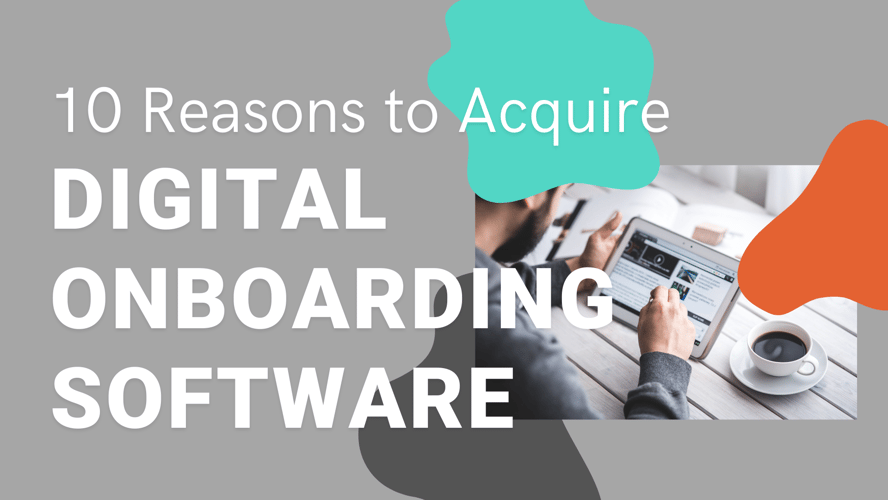Imagine undertaking the years to study the fascinating subject of Human resources.
You then finally get your foot in the door and work your way up to management.
Then there you are, ready to onboard a new employee.
But you find yourself holding a stack of paper next to a printer.
Are we back in the 80s?
Not to fret, luckily integrating onboarding software is on the rise!
Here are the top 10 must have qualities you should look out for in an employee onboarding software.
1. Digital signing on one platform
Features:
Traditional signing was previously bogged down by manual processes. These frustrating tasks included printing, signing, scanning, and mailing papers.
This is where modern digital signing comes in. This signing takes seconds from your laptop or even your mobile phone!
Data can also be pre-populated and pre-personalised in legal documents, which eliminates errors and ensures data accuracy from the recruitment stage to the onboarding stage.
Benefits:
Digital signing provides the accessibility to ensure new hires can complete their onboarding to their convenience. Simplifying the onboarding process in this way makes the candidate feel valued, and at the same time reduces the time-to-hire.
Digital signing should also be available to internal stakeholders who require signing off various items on behalf of the company. This improves workflows and communications between HR and managers/executives.
2. Mobile friendly platform
Features:
A mobile first platform efficiently utilises your new employee’s time. Displaying all segmented stages paired with a progress bar further simplifies the process by making it digestible. Consistent branding across desktop and mobile is also how new hires build a connection with their new company.
Benefits:
I remember nervously researching my workplace before my first interview. Trying to soak up all the information I could find. Then fast forwarding to seeing my new company’s logo on the top of my onboarding pack on my phone. It was like it was smiling at me!
When softwares develops mobile-first features for every interaction that a candidate has with the platform. The experience on the mobile is guaranteed to be seamless, demonstrating care and value to the new hire. Bonus points if it’s SaaS as it eliminates the need to download anything.
Alternatively, people who choose not to use mobile phones can simply use an iPad at the front desk or computers in the library.
3.Induction/ Orientation Videos
Feature:
According to the Learning lab: LinkedIn, users are 20 times more likely to share a video than other posts. The combination of visual and auditory stimulation provided by video content is more engaging and easier to digest than documents.
You can film literally anything with a mobile phone. Examples are: Tour of your office, safety procedures, training and demos. With video capabilities on mobile devices, honestly the sky’s the limit.
Video content is useful as it can remain consistent in all training processes. To ensure candidates take responsibility for watching the videos a “viewed” button must be pressed before progressing to later stages.
This type of multimedia is also able to be embedded in the onboarding software, allowing for convenient learning as it’s accessible on both mobile or desktop in one platform.
Some softwares don’t even discriminate against video sources. Anything from youtube to vimeo can be used all throughout the onboarding process.
Benefits:
Videos are a fantastic training tool as it’s entertaining and attention grabbing. Branded videos further help familiarise new hires with your company.
Using multimedia not only modernises your business but also improves brand image to new employees.
4.Paperless process
Features:
Unless you’re a pyromaniac ( which probably shouldn’t even be an excuse ) it’s time to go paperless. Storing data digitally enables it to be accessed anywhere. Storing it through an online account also offers security compared to a physical filing cabinet in an office.
Benefits:
Paperless methods ensure that neither the candidate or the HR professionals need to be in person to complete onboarding processes. There’s literally no disadvantages with going paperless. All manual tasks of creating offers, sending mail to candidates, and re-entering data into payroll will be eliminated. Costs with labour, budgets and physical storage will also all be cut. Overall the need to digitise business processes is key to remaining competitive in the present modern age
5.Creating Customised Compliance Standards
Features:
Document versioning
Compliance measures are constantly being updated. Document versioning is a strategy for HR professionals to ensure their documents are accurate. Admins can update any onboarding items to be instantly changed across all packs. No manual tasks are necessary. Our good friends over at Montefiore mentioned how digital onboarding ensured that all the managers across all the centres were using the same contract.
Using document versioning allows companies to proactively protect themselves from risk exposure. This also ensures that each onboarding pack is valid and ready to go for each hire.
Pre Employment checks
Pre-employment checks functions by not allowing the candidate to progress to the next stage before completing the required checks.
Companies can custom-create their pre-employment check workflow according to their compliance requirements and company procedures.
By implementing these pre-employment checks, new hires will progress through the onboarding pack in the order that is necessary and unique to the business. Examples of such checks are: working with children, reference checks and national police checks.
Only when all required steps are completed by a candidate, then they can begin their employment at their new company.
Benefits:
If you are still using paperwork for compliance processes, you may as well stick a message into a bottle and throw it into the ocean. Who knows where it is and where it’s going ?
Digitising compliance processes allows the data to be recorded. As this data can be easily accessed anytime, anywhere it provides strong audibility benefits. Their hardcopy predecessors could never.
Enforcing compliance helps your company prevent and detect violations of rules, which protects your organisation from fines and lawsuits.
Traditional processes are simply outdated and can’t keep up with the constant updating. Unifying all processes on one platform enables for less back and forth which also decreases risk.
6.Aesthetic and consistent branding
Features:
Onboarding packs can be fully customisable. Branded styling elements can be applied across all interactive touch points for candidates. Automating design templates allows branding to be kept consistent across all candidate portal and communication channels.
Benefits:
Your employees are your customers too! Applying aesthetic branding is a necessary step in crafting a beautiful and smooth onboarding process. New hires will become familiarised and experience the care that their companies have applied to their onboarding processes.
7.Integrated seamless SMS and email communication
Features:
Self – onboarding may be daunting to new hires. Give them a helping hand by providing constant communication. Scheduling personalised two-way SMS/Emails ensures that HR professionals provide plenty of opportunity for queries. This ensures continuous support to the new hire leading up to their start date.
Benefits:
Scheduling communication reduces workload and prioritises consistent communication. This constant communication to the new hires makes them feel valued. They will be equipped with a high understanding of their role ready to hit the ground running.
8.Automated stakeholder notifications
Features:
Using automated stakeholder notifications is explained exactly in its name ! This function notifies stakeholders on the new hires’ onboarding progression. This allows the stakeholders to action next steps. For eg. procurement managers need to be notified to order uniforms and wait for delivery before the new hire comes in for their first day.
Benefits:
Automating the process in this manner significantly reduces waiting times. The earlier everyone is notified the earlier the hire can start.
9. Deadline Timers
Features:
By informing stakeholders on candidate onboarding deadlines, empowers them to make better use of their time. Timers are able to be custom-set for each onboarding pack.
Benefits:
By creating this urgency for candidates demonstrates that their new workplace has set expectations and values their time. When candidates are aware of an onboarding timer, time delays and candidate drop offs are reduced.
10. Agnostic payroll integration
Features:
Agnostic payroll integration means that the onboarding software can be integrated with any payroll vendor. Data collected through the recruitment and onboarding phases can be automatically pushed into the payroll system used in the organisation.
Benefits:
Data integration leads to cost savings, and reduced errors.
HR managers have a lot on their plate. Manual tasks are time consuming and boring tasks for these talented people. These archaic methods must be stopped ! Especially when there are life-saving softwares perfectly crafted to do everything, minus the human error.
Utilise onboarding softwares to: reduce drop-off, shorten Time-to-hire, Increase Compliance, Save Costs, and make Managers Happy.





Blog comments